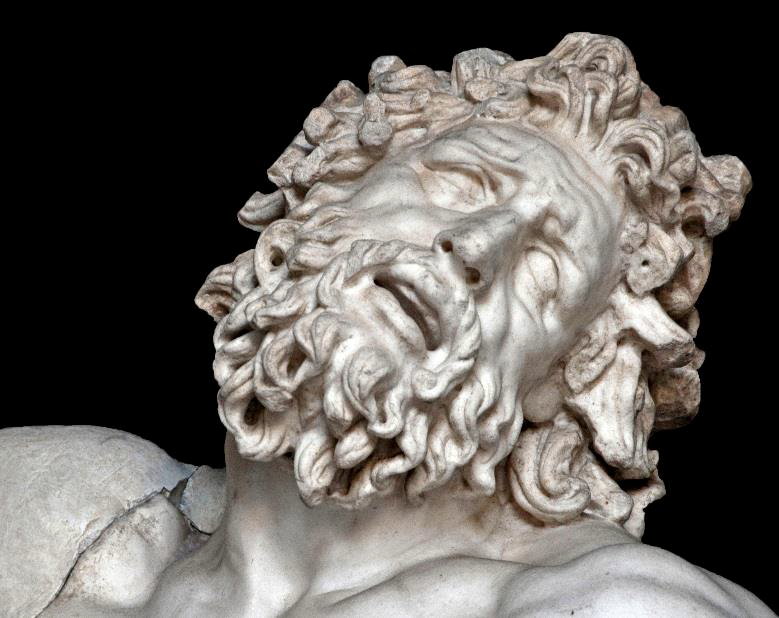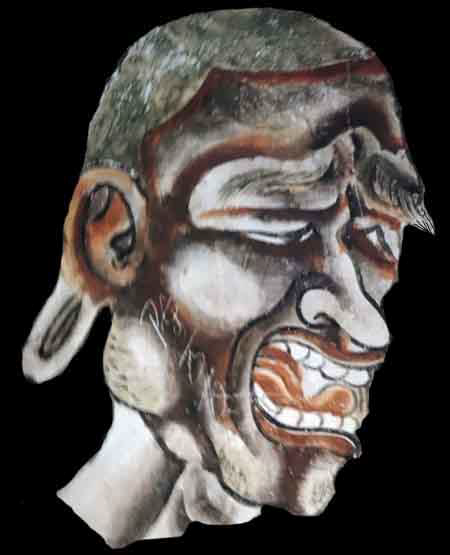Power and Pathos: Bronze Sculpture of the Hellenistic World
J. Paul Getty Museum
Skylla-Gruppe aus Sperlonga: der Kopf des Steuermanns
zeigt deutliche Übereinstimmungen mit dem des Laokoon
http://syndrome-de-stendhal.blogspot.com/2014/04/das-ultimative-antike-meisterwerk-der.html
Fig. 2. Agonized monk, Vardak, Ghandhara. Image courtesy of Prof. Osmund Bopearachchi
Fig. 3. Pain-stricken layman, V&A Museum. Image courtesy of Prof. Osmund Bopearachchi
Fig. 4. Lamenting arahat, Mogao cave No.158. Image courtesy of Prof. Osmund Bopearachchi
Hendrick Goltzius (Dutch, 1558–1617), Two Male Heads after the Antique, the Sons of Laocoön, c. 1605. Red chalk on ivory laid paper. The Art Institute of Chicago, Regenstein Acquisition Fund.
Fragmentary figure of a mourner (Gandhara, 2/3 c., Ashmolean Museum, ac. nr. EA1999.33)
http://jameelcentre.ashmolean.org/collection/4/6739/6746/11431
Fig. 5. Bronze Hellenistic statuette of a veiled and masked dancer (3rd–2nd century B.C.), MET Museum nr. 1972.118.95
The complex motion of this dancer is conveyed exclusively through the interaction of the body with several layers of dress. Over an undergarment that falls in deep folds and trails heavily, the figure wears a lightweight mantle, drawn tautly over her head and body by the pressure applied to it by her right arm, left hand, and right leg. Its substance is conveyed by the alternation of the tubular folds pushing through from below and the freely curling softness of the fringe. The woman's face is covered by the sheerest of veils, discernible at its edge below her hairline and at the cutouts for the eyes. Her extended right foot shows a laced slipper. This dancer has been convincingly identified as one of the professional entertainers, a combination of mime and dancer, for which the cosmopolitan city of Alexandria was famous in antiquity.
Medallion with Athena Wearing the Head of Medusa, 200–150 B.C., found in Thessaloniki, Greece. Bronze with inlaid white glass, 10 11/16 in. high. The Hellenic Ministry of Culture, Education and Religious Affairs. The Archaeological Museum of Thessaloniki, 17540. Image © Hellenic Ministry of Culture and Sports /Archaelogical Receipts Fund. Photo: Orestis Kourakis
Η Πηνελόπη χαλάει το υφαντό της τη νύχτα. Penelope Unraveling Her Work at Night, Dora Wheeler 1886
ΒΙΒΛΙΟΓΡΑΦΙΑ
Wong, S., and W. Yu. "Buddhist Iconography Along the Silk Road with Prof. Osmund Bopearachchi," Part Two – The Land Route, <https://www.buddhistdoor.net/features/buddhist-iconography-along-the-silk-road-with-professor-osmund-bopearachchi-part-two-the-land-route> (24 January 2021).
https://www.academia.edu/108828554/Imitatio_Alexandri_in_Hellenistic_Art_Portraits_of_Alexander_the_Great_and_Mythological_Images?auto=download&email_work_card=download-paper&fbclid=IwAR0r5aamAZrFFiqPYcoJ69IFVQqZcDPrXNtQuqldYkWMSRuOZTDb7U8SXh4
Trofimova, A. 2012. Imitatio Alexandri in Hellenistic Art. Portraits of Alexander the Great and Mythological Images, Roma.
https://www.facebook.com/permalink.php?story_fbid=pfbid029iRAkoWU3Pq1wXvnNPVWushMQnh9RK21cJbDsqE2FjCzvREojYdN3YZyYtirDrqdl&id=100052896971032&__cft__[0]=AZXp4XyT8eu8thayMhN78kMn-PlyQaepIBSJ4MKHGVYhboO_gr7kRByOgqfTBuAJgvx79olGRp8ABDQT60SQLQOEuGMMgF-Jp_ISjQiEQbvZPmBb5A1sLp8PGKA7cpRNHKo&__tn__=%2CO%2CP-R
https://www.academia.edu/108828554/Imitatio_Alexandri_in_Hellenistic_Art_Portraits_of_Alexander_the_Great_and_Mythological_Images?auto=download&email_work_card=download-paper&fbclid=IwAR0QwaRcbjchQ8RecQzrkDUK_clcfb_ioCjtY36Ia5m_F40pP8V6UOfL1fYTrofimova, A. 2012. Imitatio Alexandri in Hellenistic Art : Portraits of Alexander the Great and Mythological Images (Studia Archaeologica 187), transl. P. Williams, Roma.
https://www.academia.edu/31805520/Emotions_in_Ancient_Greek_Art?fbclid=IwAR21V0s2aA-9e5FTCDXLQyFqdvv1DrhSMfxQ-t-Mm3FM1mr2Q7V8rACJlEs
Mylonopoulos, I. 2017. "Emotions in Ancient Greek Art," in A World of Emotions: Ancient Greece, 700 BC - 200 AD, New York 2017, Onassis Foundation, pp. 72-85










